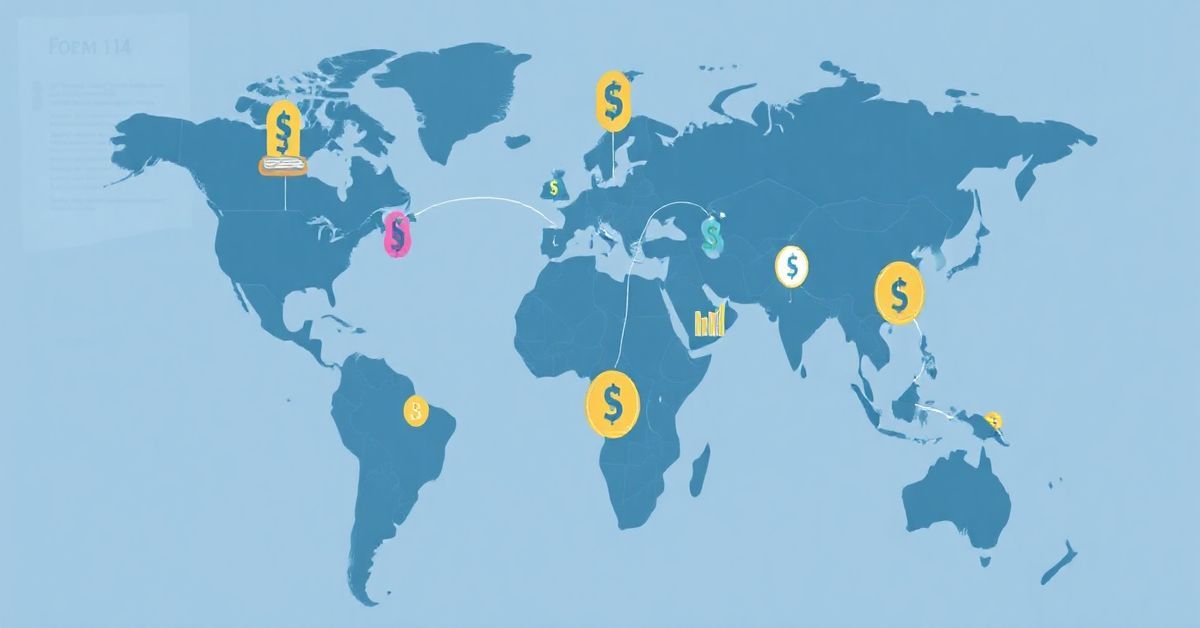Understanding the FBAR: More Than Just Foreign Bank Accounts
Hey there! Let’s talk about something that might sound a little intimidating but is actually pretty straightforward once you get the hang of it: the FBAR, or Form 114. If you’ve got money in accounts outside the US, this could be important for you.
What Exactly is the FBAR and Why Does It Exist?
The FBAR, which stands for Report of Foreign Bank and Financial Accounts, isn’t about owing more taxes directly. It’s primarily about transparency. The U.S. government wants to know about foreign financial assets owned by its citizens and residents. It’s like the government saying, “Hey, we want to make sure everyone’s playing by the rules and not hiding money overseas to avoid taxes or other illegal activities.” This information helps them keep an eye on the flow of money and helps prevent illicit financial activities. It’s a tool they use to fight tax evasion, money laundering, and other financial crimes.
The FBAR reporting requirement is actually part of the Bank Secrecy Act, a law that was put in place to fight these types of financial wrongdoings.
Who Needs to File Form 114?
So, who is this relevant to? You’ll likely need to file an FBAR if you are considered a “U.S. person” and you meet certain criteria. “U.S. person” is a specific term that includes:
- U.S. citizens: Whether you live in the U.S. or abroad.
- U.S. residents: This usually includes people who have a green card or who meet the “substantial presence test” for tax purposes.
- Entities: Such as corporations, partnerships, and limited liability companies (LLCs) organized in the United States.
- Trusts and estates established in the United States
If you are a U.S. person, you’ll need to file an FBAR if you have a financial interest in or signature authority over one or more foreign financial accounts, and the total value of those accounts exceeded $10,000 at any point during the calendar year.
What Kind of Accounts Need to Be Reported on the FBAR?
It’s important to know what types of accounts count towards the $10,000 threshold. It’s not just your traditional bank savings or checking accounts. The FBAR also includes:
- Bank accounts: Checking, savings, and any type of deposit account.
- Securities accounts: These include brokerage accounts that hold stocks, bonds, mutual funds, etc.
- Other financial accounts: This covers a wide range including insurance policies with a cash value, investment funds, and other types of financial accounts held outside the United States.
- Certain foreign pensions and retirement accounts: While not all foreign pensions need to be reported, some do. It’s best to check specific guidelines.
- Accounts held with a foreign branch of a US bank: The location of the bank matters, not the bank’s origin. If you’re using a branch of a US-based bank, but that branch is located overseas, it will likely be included in the reporting requirement.
It’s important to understand that you must report all your qualifying accounts. Even if you have less than $10,000 in any single account, you’ll have to add up the maximum balances of all foreign accounts throughout the year to see if you surpass the $10,000 threshold. It’s the aggregate total that matters.
What Does “Financial Interest” and “Signature Authority” Mean?
These are key terms when determining if you need to report an account.
- Financial Interest: This means you own the account, even if it’s not in your name alone. This can include having full ownership, a partial interest, or having beneficial ownership. It means the money in the account would ultimately benefit you. For example, if an account is held in the name of an offshore entity you control, you would still have a financial interest.
- Signature Authority: This means you can control the disposition of money or assets in an account. Even if the account doesn’t belong to you, you have signature authority if you can instruct the bank or financial institution to take action on the account. For example, a company CFO, while not the owner, might be able to transfer funds with their signature.
You could be required to report an account under either or both of these terms.
How to File an FBAR
Unlike your tax return, the FBAR is not filed with the IRS. It’s filed with the Financial Crimes Enforcement Network (FinCEN), a bureau of the US Treasury. Since 2013, the FBAR must be filed electronically through FinCEN’s BSA E-Filing System.
You’ll need specific information ready when you file. This will include:
- Your personal information (name, address, tax ID number).
- The name and address of the foreign financial institution where your account is held.
- The account numbers of your foreign accounts.
- The type of account (checking, savings, securities, etc.).
- The maximum value of each account during the calendar year.
- This is not the balance at the end of the year; you need to identify the highest balance the account had during the entire year.
- If the balance is in a foreign currency, you need to convert it to US dollars using the appropriate exchange rate.
The due date for the FBAR is April 15th, the same day as your tax return. However, there’s an automatic extension to October 15th, which is a generous extension for FBAR filers.
Penalties for Not Filing an FBAR
Not filing an FBAR, or filing it incorrectly, can lead to significant penalties. These penalties are not something to take lightly. They can be categorized as follows:
- Non-willful violations: If you make an honest mistake and fail to file, you can be penalized up to $10,000 per violation.
- Willful violations: If you knowingly fail to file or file a false report, penalties can be much higher, potentially up to $100,000 or 50% of the account balance (whichever is greater) per violation. Additionally, willful violations can carry criminal penalties.
The government takes FBAR violations seriously. They can easily track down unreported foreign accounts, and if you’re found to be non-compliant, you may face severe financial consequences. The key is to file accurately and on time. If you’re unsure about your situation, talk with a professional.
Common Mistakes and Misconceptions about the FBAR
- Thinking It’s Only About Bank Accounts: The FBAR is for more than just traditional bank accounts. Be sure to check all of your foreign assets.
- Thinking Small Amounts Don’t Matter: The threshold is the total of ALL your foreign financial accounts, so even if individual balances seem small, the totals might still cross the $10,000 mark.
- Thinking it’s part of the tax return: The FBAR is a separate filing from your tax return. It goes to FinCEN and has a separate process for e-filing.
- Assuming your financial advisor knows you need to file. While they may, it is your personal responsibility to know if the FBAR is required for you and to file it.
Tips for FBAR Compliance
- Keep good records: Keep all financial records related to your foreign accounts throughout the year. This helps you accurately determine maximum balances and keep track of relevant information.
- Check exchange rates: When converting currencies, ensure you use the appropriate exchange rates from that period. The Treasury Department has a list of exchange rates for use in your report.
- Don’t wait until the last minute. It is best to have all of your information organized well before the due date of April 15.
- Consult with a tax professional: If you’re unsure about your FBAR requirements, consult with a qualified tax advisor who understands international tax law. They can help ensure you’re in compliance and avoid costly mistakes.
The Bottom Line
The FBAR (Form 114) might seem like a complex topic, but it’s really about transparency. If you are a U.S. person with financial interests or signature authority over foreign accounts totaling more than $10,000, it’s crucial to understand your filing obligations. Failing to file or filing improperly can lead to significant penalties, so it’s best to be informed and diligent. If you are ever uncertain about your specific situation, seek professional help.

